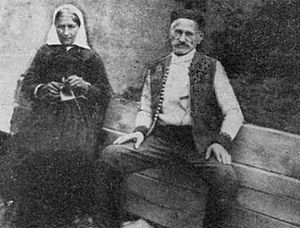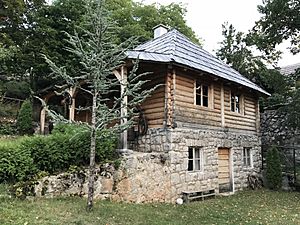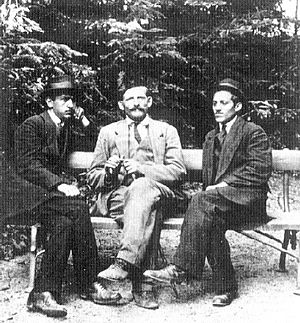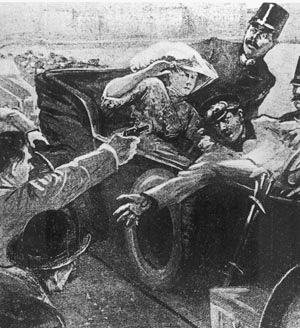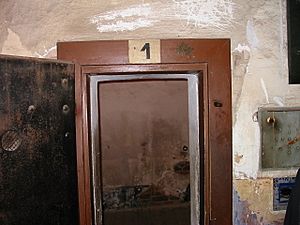Gavrilo Princip facts for kids
Quick facts for kids
Gavrilo Princip
|
|
|---|---|
| Гаврило Принцип | |
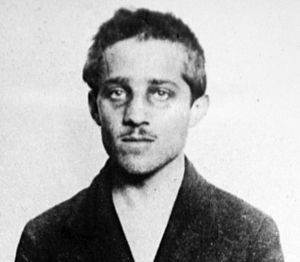
Princip in his prison cell c. 1915
|
|
| Born | 25 July 1894 |
| Died | 28 April 1918 (aged 23) Terezín Fortress, Bohemia, Austria-Hungary
|
| Resting place | Vidovdan Heroes Chapel, Sarajevo |
| Known for | Assassination of Archduke Franz Ferdinand |
| Conviction(s) | High treason Murder (2 counts) |
| Criminal penalty | 20 years imprisonment |
| Signature | |
 |
|
Gavrilo Princip (Serbian Cyrillic: Гаврило Принцип, pronounced [ɡǎʋrilo prǐntsip]; 25 July 1894 – 28 April 1918) was a Bosnian Serb student who assassinated Archduke Franz Ferdinand of Austria and his wife Sophie, Duchess of Hohenberg, in Sarajevo on 28 June 1914.
Contents
Biography
Princip was born in the remote hamlet of Obljaj, near Bosansko Grahovo, on 25 July [O.S. 13 July] 1894, to a poor Serb family. He was the second of his parents' nine children, six of whom died in infancy. At birth, Princip was a sickly infant, so the local priest recommended to name him after the Archangel Gabriel, which would help him survive.
Princip began attending primary school in 1903, aged nine. He overcame a difficult first year and became very successful in his studies, for which he was awarded a collection of Serbian epic poetry by his headmaster.
At the age of 13, he was sent to Sarajevo, the capital of Austrian-occupied Bosnia, to study at the Merchants’ School. His elder brother Jovan paid for his tuition with the money he earned performing manual labour, carrying logs from the forests surrounding Sarajevo to mills within the city.
After three years of study, Gavrilo transferred to the Sarajevo Gymnasium where he got interested in politics. In 1911, he joined Young Bosnia, a secret local society that aimed to free Bosnia from Austrian rule and achieve the unification of the South Slavs.
In 1912, after attending anti-Austrian demonstrations in Sarajevo, he was expelled from school and walked to Belgrade, Serbia to continue his education. In June 1912, he went to the First Belgrade Gymnasium to take the fifth grade exam which he failed.
During the First Balkan War, Princip traveled to Southern Serbia to volunteer with the Serbian army's irregular forces fighting against the Ottoman Empire but was rejected for being too small and weak.
In the summer of 1913 Princip passed the fifth and sixth grades of high school. In early 1914 he left Sarajevo for Belgrade, stopping briefly in his village to see his parents. While in Belgrade preparing for his sixth-class examinations in the First Belgrade High School, Princip was shown by his friend Nedeljko Čabrinović a newspaper cutting announcing Archduke Franz Ferdinand of Austria's visit to Bosnia in June. Princip decided to lead a group of assassins back to Bosnia and attack the Archduke during his official visit to Sarajevo.
Assassination plot
Princip convinced Milan Čabrinović and his old schoolfriend Trifko Grabež to join the plot.The Black Hand, a Serbian secret society with ties to Serbian military intelligence, provided the conspirators with weapons and training and helped them with getting to Bosnia.
On Sunday 28 June 1914 during the royal couple's visit to Sarajevo, six of the conspirators took the bombs and guns and waited for Ferdinand to drive past. Every one of them failed.
Suddenly, Princip saw Ferdinand in his car. The driver of the car had driven his car the wrong way and he stalled the car while trying to turn. Princip walked up and shot Ferdinand. He wanted to shoot the general who was also sitting in the car, but Ferdinand's wife Sophie threw her arms around Ferdinand. She was in the way, and Princip shot her instead of the general.
Arrest and trial
Princip was arrested immediately and tried alongside twenty-four others, all Bosnians and thus Austro-Hungarian subjects. At his trial, Princip stated: "I am a Yugoslav nationalist, aiming for the unification of all Yugoslavs, and I do not care what form of state, but it must be free from Austria."
Princip was spared the death penalty because of his age (19) and sentenced to twenty years in prison. He was imprisoned at the Terezín fortress in northern Bohemia (now in the Czech Republic).
Aftermath
Because this crime happened, Austria-Hungary gave Serbia a list of things that Serbia had to do, later called the "July Ultimatum", to stop things like this from happening any more. Serbia could not do all the things on the list fast enough, because the Austrians really wanted war with Serbia. Their German allies also wanted a big war. This led to many of the European countries to start fighting.
Many historians believe that the assassination of Franz Ferdinand triggered the World War I.
Imprisonment and death
Princip was chained to a wall in solitary confinement. He died on 28 April 1918 from tuberculosis caused by poor prison conditions which had already caused the loss of his right arm.
Fearing his bones might become relics for Slavic nationalists, Princip's prison guards secretly took the body to an unmarked grave, but a Czech soldier assigned to the burial remembered the location. In 1920 Princip and the other "Heroes of Vidovdan" were exhumed and brought to Sarajevo, where they were buried together beneath the Vidovdan Heroes Chapel "built to commemorate for eternity our Serb heroes" at the Holy Archangels Cemetery.
Legacy
Long after his death, Princip's legacy is still disputed. For the Habsburg monarchy and its supporters, he was a murderous terrorist. Royal Yugoslavia portrayed him as a Yugoslav hero.
In the 90s, Princip started to be seen by some as a Serbian nationalist acting for the creation of a Greater Serbia. Political movements and regimes have either praised or demonized him in order to promote their ideology.
Today he is still celebrated as a hero by numerous Serbs and regarded as a terrorist by many Croats and Bosniaks.
Memorials and commemoration
The house where Princip lived in Sarajevo was destroyed during World War I. After the war, it was rebuilt as a museum in the Kingdom of Yugoslavia. Yugoslavia was conquered by Germany in 1941 and Sarajevo became part of the Independent State of Croatia. The Croatian Ustaše destroyed the house again. After the establishment of Communist Yugoslavia in 1944, the house of Gavrilo Princip became a museum again and there was another museum dedicated to him within the city of Sarajevo. During the Yugoslav Wars of the 1990s, the house of Gavrilo Princip was destroyed and then rebuilt for the third time in 2015.
Princip's pistol was confiscated by the authorities and eventually given, along with the Archduke's blood-stained undershirt, to Anton Puntigam, a Jesuit priest who was a close friend of the Archduke and had given the Archduke and his wife their last rites. The pistol and shirt remained in the possession of the Austrian Jesuits until they were offered on long-term loan to the Museum of Military History in Vienna in 2004. It is now part of the permanent exhibition there. During the Yugoslavian era, Latin Bridge, the site of the assassination, was renamed Princip's Bridge in remembrance; it reverted to its old name Latinska Cuprija in 1992. In Sarajevo about a half-dozen memorials to Gavrilo Princip have been erected on the site and torn down with each change in power.
In 1917, a pillar was constructed at the corner of where the assassination took place. It was destroyed the following year. In 1941, the 1930 plaque commemorating Princip was removed by the local Germans when the German Army invaded. It was presented to Adolf Hitler as a birthday gift and kept in a museum, only to be lost after 1945. After World War II, a new plaque went up which claimed that "Gavrilo Princip threw off the German occupiers". During the Bosnian War, embossed footprints marking where Princip fired the fatal shots were torn out.
As the centenary of the assassination neared, an apolitical plaque was put up at the corner where the assassination took place, which states: "From this place on 28 June 1914, Gavrilo Princip assassinated the heir to the Austro-Hungarian throne Franz Ferdinand and his wife Sofia." On 21 April 2014, a bust of Princip was unveiled in Tovariševo, and on the centenary itself, a statue was erected in East Sarajevo. A year later, a statue of Princip was unveiled in Belgrade by the President of Serbia Tomislav Nikolić and the President of Republika Srpska Milorad Dodik, as a gift from Republika Srpska to Serbia. At the unveiling Nikolić gave a speech, saying in part: "Princip was a hero, a symbol of liberation ideas, tyrant-killer, idea-holder of liberation from slavery, which spanned through Europe".
On 11 November 2018, the 100th anniversary of the end of World War I, Princess Anita of Hohenberg, the eldest great-grandchild of Archduke Franz Ferdinand and Branislav Princip, grandnephew of Gavrilo Princip, shook hands in a symbolic act of reconciliation in Graz, Austria.
In film
In the German drama film 1914 (1931), Carl Balhaus played Gavrilo Princip. Irfan Mensur played Princip in The Day That Shook the World (1975), based on the assassination. He was portrayed by Eugen Knecht in Sarajevo (2014), a German-Austrian television film based on the assassination, and by Joel Basman in The King's Man (2021), the third film in the Kingsman fiction film series.
Images for kids
See also
 In Spanish: Gavrilo Princip para niños
In Spanish: Gavrilo Princip para niños


